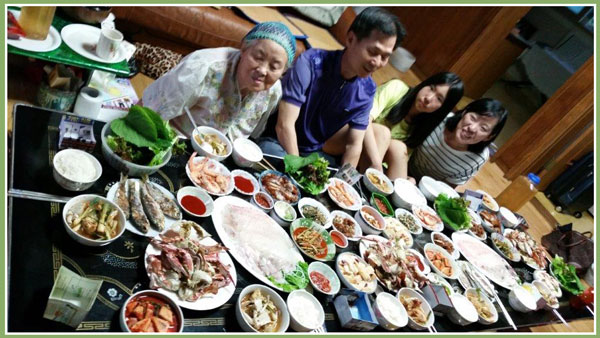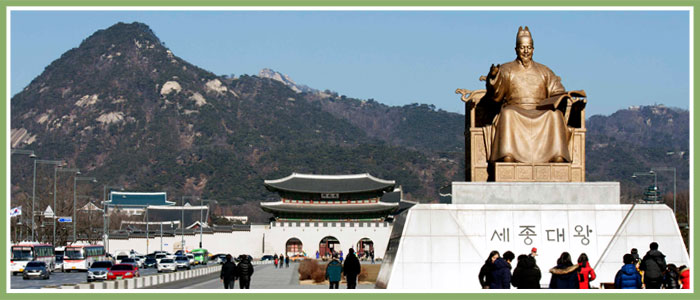Thoughts on Korea
Preconceptions and First Impressions
Prior to traveling to Korea, I am embarrassed to admit that I was expecting a country and a culture far less developed, and far less sophisticated, than the one I found. The streets are wide, clean and well-trafficked by cars (rather than the teams of bicycles one might see in a large Chinese city) and the subway system is efficient and comprehensive. Restaurants and department stores abound. Seoul, where I spent the majority of my time, is as modern and contemporary a city as New York or any of the world’s other major capitals. And yet, like its large European counterparts, Seoul has retained a great deal of its historical charm.
After spending a few days in Korea, I thought a lot about why the country that I had imagined fell so far short of the country that I found. I think the answer is fairly simple: when Americans hear about Korea, they almost always hear about North Korea, its terrible conditions and the tension between that country and our own. We should be hearing about North Korea, of course. But hearing solely about North Korea undoubtedly leads to the impression that South Korea, too, is some sort of Third World nation. That couldn’t be further from reality, as I hope the following comments will make clear.
Food
Korean food is strikingly different from American cuisine. Forget about staples like bread and cheese; although you’ll still find them in McDonald’s, you won’t find them in a traditional Korean restaurant. What you will find is a wide variety of vegetables. When we think of vegetables, though, we usually think “green”: lettuce, broccoli, peas, and peppers. However, vegetables in Korea explode with color. They are yellow, purple and, due to a healthy use of chili powder, often very red. Yet the variety in Korean vegetable dishes isn’t reflected solely in their color. Koreans use so many different parts of the same vegetable that any individual plant can yield several different dishes – roots, stems and leaves are frequently put to use. Moreover, the way in which vegetables are served in Korea leads to even more variety. Rather than, say, serving a main dish with sides of two different vegetables, Koreans begin each meal with half-a-dozen or more tapas-like small plates, each of which feature something different.

A delicious buffet of food in Seoul, Korea
When the main course does arrive – and at Korean restaurants you rarely have to wait very long – the variety continues. Fish, shellfish, chicken and beef are all standard and, interestingly, are all used differently. One day you may have crab in a soup, the next day it’s crab served cold, the next day your eating barbequed beef, and the next day its rice and vegetables topped with a fried egg. The variety is not only interesting and fun, but it keeps you from tiring of the cuisine.
I couldn’t write about Korean food without mentioning the one dish that Koreans eat with every meal (breakfast included) – kimchi. Kimchi is a pickled vegetable dish, generously flavored with chili peppers, that accompanies everything. And, although the pickled vegetable is most often cabbage, kimchi doesn’t escape the Korean penchant for variation – it can be made from dozens of vegetables. It’s spicy, but it’s very flavorful and very healthy.
People
It’s not easy to generalize about a group of people numbering in the tens of millions. Nevertheless, some patterns emerged. First, I found Koreans to be enormously hospitable and welcoming. There were a number of occasions when I was standing on a street corner, straining to decipher a map and, essentially, fitting neatly into the stereotype of the hopelessly lost tourist. On nearly each of these occasions, a Korean approached and asked – in English – if he or she could help. And again at restaurants, the staff always endeavored to explain that a dish might be particularly spicy or particularly unusual. Although some of these exchanges were less than helpful – English is not nearly as pervasive in Korea as it is in Western Europe, for instance – the effort to make me feel welcome was always there.
This is not to say that every Korean rolled out the red carpet for me. Although Korean religious affiliation is far more pluralistic than in the United States, Confucianism – with its focus on tradition, reverence for the elderly and male power – is still a significant force, especially among older members of the population. This becomes apparent when – as happened to me on a number of occasions – an older gentleman cut a line without explanation or pushed me in the back while moving through a crowded street. This isn’t to illuminate examples of “rude” Koreans, but rather to point out that such behavior isn’t considered rude at all – it’s a normal part of life. The gap between how accepted this is in Korea and how totally unacceptable it would be considered in the United States was probably the most striking difference between Korea and the United States that I observed.
Finally, a note to business travelers: bring a lot of business cards. Not only will you be expected to exchange business cards with everyone present at a business meeting, but it is likely that those Koreans who you may meet casually and socially will expect the same.
Aesthetics
Before arriving in Seoul, I was most curious to answer the question, “What will the city look like?” The question arose, I think, out of my ignorance of East Asia. Most Americans are of European descent and, for that reason, as well as for reasons of distance and language, we are far more familiar with images of London, Paris and Rome than of Seoul, Tokyo and Beijing. And when we do see depictions of East Asia, they often veer between two extremes, either highlighting the region’s ancient roots – wooden roofs, traditional garb, tea ceremonies and the like – or scenes of urban overcrowding – throngs of people swimming down a crowded sidewalk bathed in neon. Although I suspected that neither image told the whole story, I was nevertheless unsure about how to fill in the blanks.
After exploring Seoul, my suspicion was confirmed: neither image dominated the city. However, I was delighted to find that both depictions revealed aspects of the city and, indeed, that Seoul had evolved in a way that blended the two together, without overdosing on either. In the neighborhood in which I spent the most time – Insadong – small alleys, dotted with traditional restaurants and tea shops, snaked their way between twelve-lane thoroughfares that featured some of the most contemporary hotels and shopping centers I have ever seen. Indeed, the city’s most upscale mall – Shinsagae – is bordered on one side by one of its oldest flea markets – Namnaemun. In my view, this is no accident, but instead reflects the nation’s commitment to balancing the great pride it takes in its historical tradition with its ambition to be a major player on the world economic, political and cultural stage.
Final Thoughts
I can think of no more appropriate phrase to describe Korea than the one it recently adopted as a national slogan: “Dynamic Korea.” The nation features 500 year-old palaces and five-star hotels; handmade woodwork and factory made televisions; a passion for baseball and for its ancient martial arts. Korea may seem quite foreign to most Americans. However, if you look around, you’re bound to see how deeply Korean products have penetrated the American marketplace. LG televisions, Samsung cell phones and KIA cars are in every city in America. It would be a shame, though, if buying a television was the extent of our interaction with Korea. It is a place of great depth, texture and richness and an extremely worthy destination for either one’s next sales trip or vacation.
Written by N.R.

